#i kept the actual p4lm1stry stuff so vague lol. that's bc i don't know the first thing about it
Text
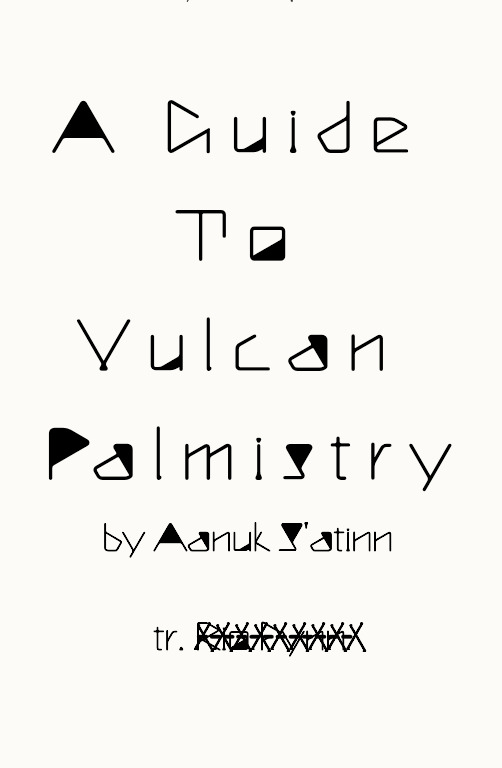

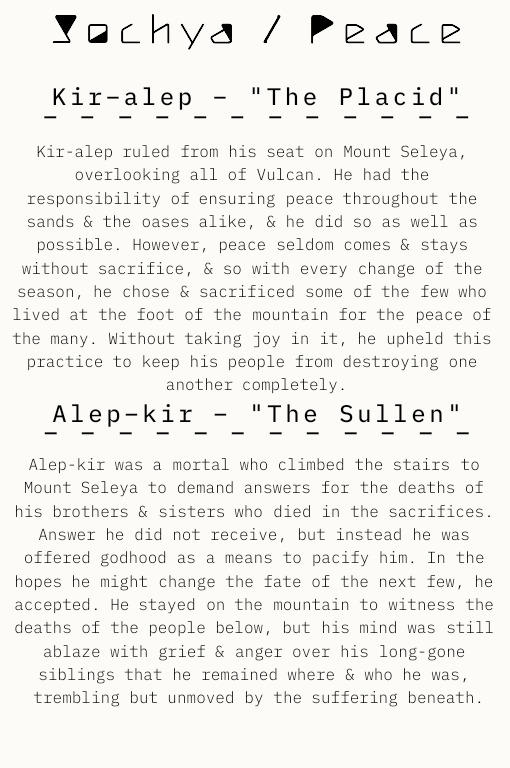

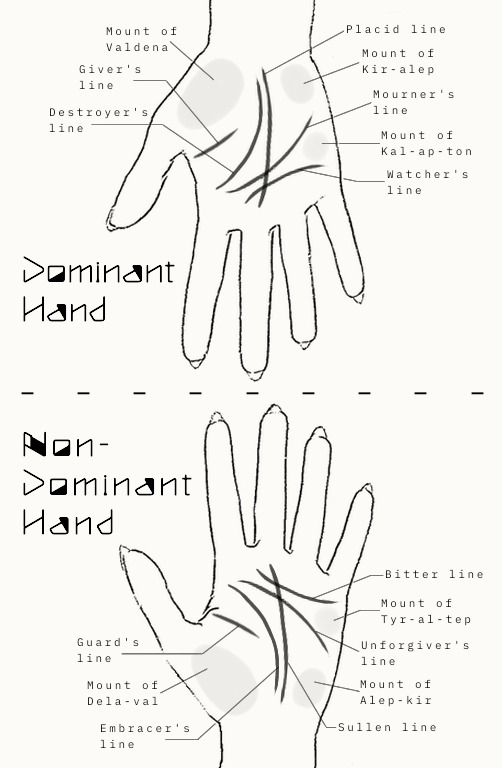
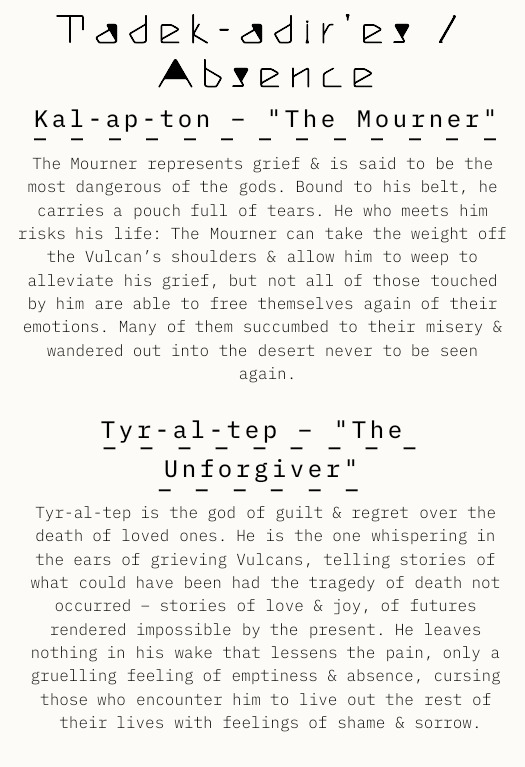

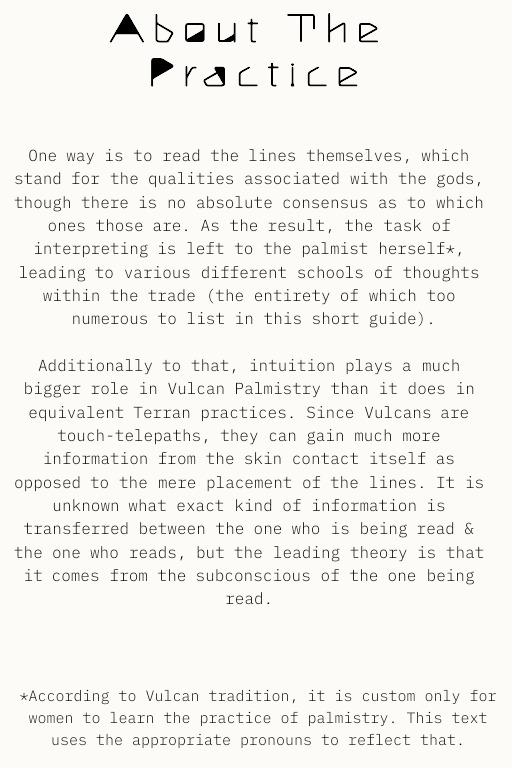
Here's the guide on AO3 (it comes with a complementary K/S fic ☆).
text version under the cut ⤵
Gods & Goddesses
Fai-tukh (Knowledge)
Tel-alep – “The Watcher”
The first wise god to ever walk on Vulcan’s sands was Tel-alep. He collected all available Vulcan knowledge & filled his library with carved stone tablets, vellum papers, incised bones & shells, colourful knotted cords. He gave as he took, & shared his collection with whoever wanted to learn. In times of conflict, Vulcans turned away from him, caring more for their immediate safety than abstract knowledge – & Tel-alep seemingly vanished. It is said he still watches all of Vulcan from the shadows & meticulously chronicles its history, as well as notes every advancement in the sciences.
Alep-tel – “The Bitter”
The second wise god of Vulcan was Alep-tel, who came to restore what was left of Tel-alep’s collection after the war that had led to it being abandoned by Tel-alep & the mortals. Piecing together what he could & collecting old knowledge to fill the gaps left by time, he spent a hundred seasons alone, caring for what he had inherited. When he was finished, the library opened its doors again to whomever wanted to learn, but the passing of time had placed it into obscurity – as the legends go, Alep-tel still spends most of his days in solitude, waiting for willing students, growing old & bitter.
Sochya (Peace)
Kir-alep – “The Placid”
Kir-alep ruled from his seat on Mount Seleya, overlooking all of Vulcan. He had the responsibility of ensuring peace throughout the sands & the oases alike, & he did so as well as possible. However, peace seldom comes & stays without sacrifice, & so with every change of the season, he chose & sacrificed some of the few who lived at the foot of the mountain for the peace of the many. Without taking joy in it, he upheld this practice to keep his people from destroying one another completely.
Alep-kir – “The Sullen”
Alep-kir was a mortal who climbed the stairs to Mount Seleya to demand answers for the deaths of his brothers & sisters who died in the sacrifices. Answer he did not receive, but instead he was offered godhood as a means to pacify him. In the hopes he might change the fate of the next few, he accepted. He stayed on the mountain to witness the deaths of the people below, but his mind was still ablaze with grief & anger over his long-gone siblings that he remained where & who he was, trembling but unmoved by the suffering beneath.
Ashaya (Love)
Valdena – “The Giver”
Love, joy, & beauty are what the goddess Valdena represents. She is usually portrayed as a Vulcan woman & is said to be the most caring of the gods – appearing as a mother, a sister, a wife, a daughter, depending on what role she fulfils for whoever encounters her. Even though she is associated with all kinds of love, not just the romantic one, many legends about her have the (re-)union of star-crossed lovers as a central theme.
Dena-vel – “The Guard”
Dena-vel is the goddess of love & possessiveness. She seeks to hide the beauty of the world she loved to keep it from strange eyes & hands. She is said to have helped build the walls that once encompassed the city of Gol, where the best artists, sculptures, poets, & musicians used to live. As a fierce protector who knows little boundaries when it comes to fulfilling her duty, many legends about her are written in blood.
Tadek-adir’es (Absence)
Kal-ap-ton – “The Mourner”
The Mourner represents grief & is said to be the most dangerous of the gods. Bound to his belt, he carries a pouch full of tears. He who meets him risks his life: The Mourner can take the weight off the Vulcan’s shoulders & allow him to weep to alleviate his grief, but not all of those touched by him are able to free themselves again of their emotions. Many of them succumbed to their misery & wandered out into the desert never to be seen again.
Tyr-al-tep – “The Unforgiver”
Tyr-al-tep is the god of guilt & regret over the death of loved ones. He is the one whispering in the ears of grieving Vulcans, telling stories of what could have been had the tragedy of death not occurred – stories of love & joy, of futures rendered impossible by the present. He leaves nothing in his wake that lessens the pain, only a gruelling feeling of emptiness & absence, cursing those who encounter him to live out the rest of their lives with feelings of shame & sorrow.
Vaikaya (Devotion) or Sa-kai-lar (Brothers)
Ket-cheleb – “The Destroyer”
Anger & rage are what moved Ket-cheleb to kill his brother, & those emotions are what he brings to all those who cross his path. His broad & rough hands carry weapons of all kinds, & he is said to often appear where he is welcomed the least – whenever there is no predetermined course of action to a conflict, no specific decision yet towards peace or violence, he will appear & tip the scales towards the latter. Many tales about wars from ancient times describe Ket-cheleb arriving at the first light in the morning & the last light at night falling over battlefields full of dead.
Cheleb-vel – “The Embracer”
If Vulcans had saints, Cheleb-vel would be the one of the black sheeps. He stands for acceptance & blindness & indifference out of love, even in regards to the things in life that are the hardest to accept. Without judgement, Cheleb-vel stands by the sides of even outcast & hated Vulcans, often being the only one to acknowledge their existence. It is said that Cheleb-vel handed his brother the stone with which he struck him dead in the vast red desert, & never harboured resentment for him in his last moments.
About The Practice
One way is to read the lines themselves, which stand for the qualities associated with the gods, though there is no absolute consensus as to which ones those are. As the result, the task of interpreting is left to the palmist herself*, leading to various different schools of thoughts within the trade (the entirety of which too numerous to list in this short guide).
Additionally to that, intuition plays a much bigger role in Vulcan Palmistry than it does in equivalent Terran practices. Since Vulcans are touch-telepaths, they can gain much more information from the skin contact itself as opposed to the mere placement of the lines. It is unknown what exact kind of information is transferred between the one who is being read & the one who reads, but the leading theory is that it comes from the subconscious of the one being read.
*According to Vulcan tradition, it is custom only for women to learn the practice of palmistry. This text uses the appropriate pronouns to reflect that.
#this cost me way too many nerves to still look that wonky. christ.#*bones voice* dammit jim i'm a librarian not a graphic designer#vulcan culture#star trek#vulcans#on vulcans#i kept the actual p4lm1stry stuff so vague lol. that's bc i don't know the first thing about it#vulcan religion#spirk#k/s#rio.write#rio.png#worldbuilding#vulcan#ancient vulcan#pre-reform vulcan#pre-surak vulcan
116 notes
·
View notes